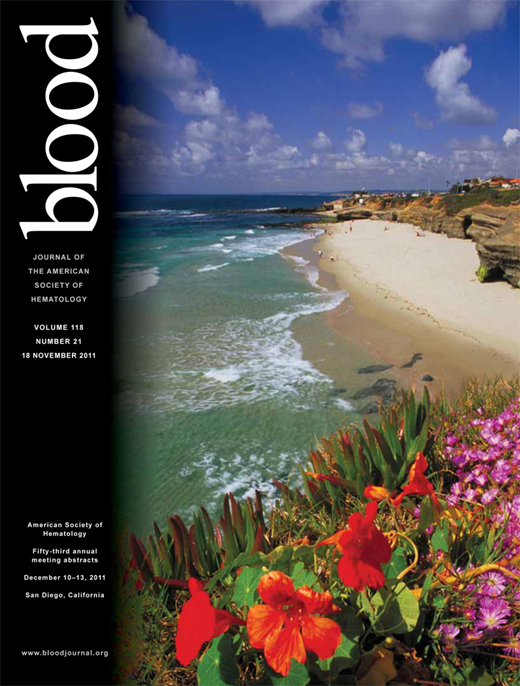Abstract
Abstract 1889
We have previously shown that G-CSF administration impairs HSC niches in the mobilized bone marrow (BM). G-CSF causes rapid suppression (within 2 days) of endosteal osteoblasts and bone formation with concomitant down-regulation of Kit ligand, CXCL12 and angiopoietin-1. This effect is mediated by the depletion of specific populations of BM macrophages1 . Considering the very rapid impairment of HSC niches in response to G-CSF, we hypothesized that 1) the most primitive HSC should also mobilize at this very early stage within the first 48 hours of G-CSF treatment, and 2) that down-regulation of HSC niche function should also alter the number or function of HSC remaining in the mobilized BM. To test this, 125μg/kg rhuG-CSF was injected twice daily to C57BL/6 mice; blood and BM harvested at days 2 and 5 of G-CSF treatment to be transplanted into congenic recipients in a long-term competitive repopulation assay (LT-CR).
Transplantation of 25μL blood showed a gradual increase in the number of LT-CR cells mobilized in response to G-CSF as measured by donor chimerism in myeloid and B lineages at 16 weeks post-transplant. Expectedly repopulating units (RU) per mL blood progressively increased from 0.2 ± 0.0 (n=6) in steady-state to 2.9 ± 1.6 (n=9) and 82.6 ± 40.4 (n=9) at days 2 and 5 of G-CSF treatment respectively. At 16 weeks post-transplant, BM from primary recipients were transplanted into secondary recipients. Surprisingly, secondary recipients of blood samples collected after 2 and 5 days of G-CSF treatment had equivalent levels of donor chimerism (37.2% ± 6.6% for 2 days G-CSF and 47.1% ± 7.8% for 5 days G-CSF, n = 8 per group). Therefore, although the absolute number of RU mobilized at day 2 of G-CSF was 28-fold lower than at day 5 of G-CSF administration, more primitive serially reconstituting HSC were mobilized at equivalent levels at days 2 and 5 of G-CSF treatment. This supports our hypothesis that most potent serially reconstituting HSC are mobilized as early as day 2 of G-CSF treatment consistent with the disappearance of osteoblasts1 .
To test the potential of HSC remaining in the BM, BM cells from G-CSF mobilized mice were transplanted in competition with BM cells from congenic mice in steady-state. Donor chimerism at 16 weeks post-transplant showed that competitive repopulation of BM cells was severely impaired at day 5 of G-CSF treatment with the number of RU per 200,000 BM cells decreasing from 4.1 ± 1.4 in steady-state and 5.2 ± 1.6 at day 2 of G-CSF treatment, to only 0.14 ± 0.05 at day 5 of G-CSF treatment. To test whether this 29-fold decrease in competitive repopulation was due to increased HSC proliferation, we measured BrdU incorporation for the last 2.5 days prior to BM harvest as well as cell cycle analysis with Ki67 and Hoechst33342. The proportion of quiescent Lin- Sca1+ Kit+ CD48- phenotypic HSC in G0 phase decreased from 62.8 ±4.0% in steady-state to 43.5±8.2% at day 2 of G-CSF, but surged back to 80.5±1.9% and 75.1±3.5% at days 3.5 and 5 of G-CSF treatment. The proportion of HSC in G1 and S/G2/M phases followed the opposite pattern, up at day 2, down at days 3.5 and 5. This was confirmed by BrdU incorporation for 2.5 days with the number of BrdU+ cells among Lin- Sca1+ KIT+ CD48- cells rising from 35.1±4.0% in steady-state, to 51.2±4.5% at day 2 of G-CSF and going down to 18.1±1.9% at day 3.5 and 23.3±5.5% at day 5 of G-CSF. Therefore, G-CSF recruits phenotypic HSC into cell cycle within the first 2 days of administration, but HSC return to quiescence despite continuing G-CSF. Therefore decreased repopulation potential at day5 of G-CSF is not due to increased cycling. Finally, we noted that the number of Lin-Sca1+KIT+CD48-CD150+ HSC and Lin-Sca1+KIT+CD48-CD150- multipotent progenitors were reduced 2.4- and 2.8-fold respectively (p<.05) in G-CSF-mobilized BM. In conclusion, administration of G-CSF rapidly disrupts HSC niches resulting in rapid mobilization of serially-reconstituting LT-CRC as early as day 2 of G-CSF administration. Secondly, the marked reduction of competitive reconstitution potential of mobilized BM was not due to increased HSC cycling but rather to decreased number of HSC remaining in mobilized BM.
No relevant conflicts of interest to declare.
1.
Author notes
Asterisk with author names denotes non-ASH members.

